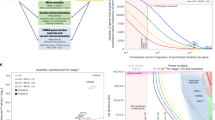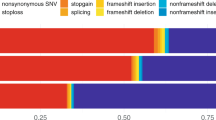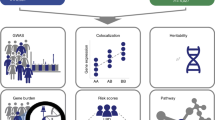Abstract
Genome-wide association studies (GWAS) have identified several risk variants for late-onset Alzheimer's disease (LOAD)1,2. These common variants have replicable but small effects on LOAD risk and generally do not have obvious functional effects. Low-frequency coding variants, not detected by GWAS, are predicted to include functional variants with larger effects on risk. To identify low-frequency coding variants with large effects on LOAD risk, we carried out whole-exome sequencing (WES) in 14 large LOAD families and follow-up analyses of the candidate variants in several large LOAD case–control data sets. A rare variant in PLD3 (phospholipase D3; Val232Met) segregated with disease status in two independent families and doubled risk for Alzheimer’s disease in seven independent case–control series with a total of more than 11,000 cases and controls of European descent. Gene-based burden analyses in 4,387 cases and controls of European descent and 302 African American cases and controls, with complete sequence data for PLD3, reveal that several variants in this gene increase risk for Alzheimer’s disease in both populations. PLD3 is highly expressed in brain regions that are vulnerable to Alzheimer’s disease pathology, including hippocampus and cortex, and is expressed at significantly lower levels in neurons from Alzheimer’s disease brains compared to control brains. Overexpression of PLD3 leads to a significant decrease in intracellular amyloid-β precursor protein (APP) and extracellular Aβ42 and Aβ40 (the 42- and 40-residue isoforms of the amyloid-β peptide), and knockdown of PLD3 leads to a significant increase in extracellular Aβ42 and Aβ40. Together, our genetic and functional data indicate that carriers of PLD3 coding variants have a twofold increased risk for LOAD and that PLD3 influences APP processing. This study provides an example of how densely affected families may help to identify rare variants with large effects on risk for disease or other complex traits.
This is a preview of subscription content, access via your institution
Access options
Subscribe to this journal
Receive 51 print issues and online access
We are sorry, but there is no personal subscription option available for your country.
Buy this article
- Purchase on SpringerLink
- Instant access to full article PDF
Prices may be subject to local taxes which are calculated during checkout



Similar content being viewed by others
Accession codes
Data deposits
The authors declare competing financial interests: details are available in the online version of the paper. Exome-sequencing data is available on NIAGADs (https://www.niagads.org, accession number NG00033).
References
Bertram, L., McQueen, M., Mullin, K., Blacker, D. & Tanzi, R. The AlzGene Database. Alzheimer Research Forum. http://www.alzgene.org (26 January 2013)
Lambert, J. C. et al. Extended meta-analysis of 74,046 individuals identifies 11 new susceptibility loci for Alzheimer's disease. Nature Genet. http://dx.doi.org/10.1038/ng.2802 (27 October 2013)
Goate, A. & Hardy, J. Twenty years of Alzheimer's disease-causing mutations. J. Neurochem. 120 (Suppl. 1). 3–8 (2012)
Jonsson, T. et al. A mutation in APP protects against Alzheimer's disease and age-related cognitive decline. Nature 488, 96–99 (2012)
Benitez, B. A. et al. TREM2 is associated with the risk of Alzheimer's disease in Spanish population. Neurobiol. Aging 34, e1715–e31717 (2013)
Benitez, B. A. & Cruchaga, C. TREM2 and neurodegenerative disease. N. Engl. J. Med. 369, 1567–1568 (2013)
Guerreiro, R. et al. TREM2 variants in Alzheimer's disease. N. Engl. J. Med. 368, 117–127 (2013)
Jonsson, T. et al. Variant of TREM2 associated with the risk of Alzheimer's disease. N. Engl. J. Med. (2013)
Cruchaga, C. et al. Rare variants in APP, PSEN1 and PSEN2 increase risk for AD in late-onset Alzheimer's disease families. PLoS ONE 7, e31039 (2012); correction http://dx.doi.org/10.1371/annotation/c92e16da-7733-421d-b063-1db19488daa6 (2012)
Harms, M. et al. C9orf72 hexanucleotide repeat expansions in clinical alzheimer disease. JAMA Neurol. 70, 736–741 (2013)
Cruchaga, C. et al. GWAS of cerebrospinal fluid tau levels identifies risk variants for Alzheimer's Disease. Neuron (2013)
Wijsman, E. M. et al. Genome-wide association of familial late-onset Alzheimer's disease replicates BIN1 and CLU and nominates CUGBP2 in interaction with APOE. PLoS Genet. 7, e1001308 (2011)
Breitner, J. C. et al. APOE-ε4 count predicts age when prevalence of AD increases, then declines: the Cache County Study. Neurology 53, 321–331 (1999)
Kamboh, M. I. et al. Genome-wide association study of Alzheimer's disease. Transl. Psychiatry 2, e117 (2012)
Cai, D. et al. Phospholipase D1 corrects impaired βAPP trafficking and neurite outgrowth in familial Alzheimer's disease-linked presenilin-1 mutant neurons. Proc. Natl Acad. Sci. USA 103, 1936–1940 (2006)
Cai, D. et al. Presenilin-1 uses phospholipase D1 as a negative regulator of β-amyloid formation. Proc. Natl Acad. Sci. USA 103, 1941–1946 (2006)
Oliveira, T. G. et al. Phospholipase d2 ablation ameliorates Alzheimer's disease-linked synaptic dysfunction and cognitive deficits. J. Neurosci. 30, 16419–16428 (2010)
Osisami, M., Ali, W. & Frohman, M. A. A role for phospholipase D3 in myotube formation. PLoS ONE 7, e33341 (2012)
Hardy, J. & Allsop, D. Amyloid deposition as the central event in the aetiology of Alzheimer's disease. Trends Pharmacol. Sci. 12, 383–388 (1991)
Benitez, B. A. et al. Exome-sequencing confirms DNAJC5 mutations as cause of adult neuronal ceroid-lipofuscinosis. PLoS ONE 6, e26741 (2011)
Cruchaga, C. et al. Association of TMEM106B gene polymorphism with age at onset in granulin mutation carriers and plasma granulin protein levels. Arch. Neurol. 68, 581–586 (2011)
Cruchaga, C. et al. Association and expression analyses with single-nucleotide polymorphisms in TOMM40 in Alzheimer disease. Arch. Neurol. 68, 1013–1019 (2011)
Jin, S. C. et al. Pooled-DNA sequencing identifies novel causative variants in PSEN1, GRN and MAPT in a clinical early-onset and familial Alzheimer's disease Ibero-American cohort. Alzheimer’s Res. Ther. 4, 34 (2012)
Benitez, B. A. et al. The PSEN1, p.E318G Variant Increases the Risk of Alzheimer's Disease in APOE-ε4 Carriers. PLoS Genet. 9, e1003685 (2013)
Wu, M. C. et al. Rare-variant association testing for sequencing data with the sequence kernel association test. Am. J. Hum. Genet. 89, 82–93 (2011)
Liang, W. S. et al. Alzheimer's disease is associated with reduced expression of energy metabolism genes in posterior cingulate neurons. Proc. Natl Acad. Sci. USA 105, 4441–4446 (2008)
Morris, J. C. The Clinical Dementia Rating (CDR): current version and scoring rules. Neurology 43, 2412–2414 (1993)
Fagan, A. M. et al. Inverse relation between in vivo amyloid imaging load and cerebrospinal fluid Aβ42 in humans. Ann. Neurol. 59, 512–519 (2006)
McKhann, G. et al. Clinical diagnosis of Alzheimer's disease: report of the NINCDS-ADRDA Work Group under the auspices of Department of Health and Human Services Task Force on Alzheimer’s Disease. Neurology 34, 939–944 (1984)
Li, H. et al. The Sequence Alignment/Map format and SAMtools. Bioinformatics 25, 2078–2079 (2009)
Cruchaga, C. et al. SNPs associated with cerebrospinal fluid phospho-tau levels influence rate of decline in Alzheimer's disease. PLoS Genet. 6, e1001101 (2010)
Vallania, F. L. et al. High-throughput discovery of rare insertions and deletions in large cohorts. Genome Res. 20, 1711–1718 (2010)
Myers, A. J. et al. A survey of genetic human cortical gene expression. Nature Genet. 39, 1494–1499 (2007)
Forabosco, P., Ramasamy, A., Hardy, J. & Ryten, M. Insights into TREM2 biology by network analysis of human gene expression data. Neurobiol. Aging 34, 2699–2714 (2013)
Millar, T. et al. Tissue and organ donation for research in forensic pathology: the MRC Sudden Death Brain and Tissue Bank. J. Pathol. 213, 369–375 (2007)
Trabzuni, D. et al. Quality control parameters on a large dataset of regionally dissected human control brains for whole genome expression studies. J. Neurochem. 119, 275–282 (2011)
Huang, D. W., Sherman, B. T. & Lempicki, R. A. Bioinformatics enrichment tools: paths toward the comprehensive functional analysis of large gene lists. Nucleic Acids Res. 37, 1–13 (2009)
Mason, M. J., Fan, G., Plath, K., Zhou, Q. & Horvath, S. Signed weighted gene co-expression network analysis of transcriptional regulation in murine embryonic stem cells. BMC Genomics 10, 327 (2009)
Zhang, B. & Horvath, S. A general framework for weighted gene co-expression network analysis. Statist. Appl. Gen. Mol. Biol. http://dx.doi.org/10.2202/1544-6115.1128 (12 August 2005)
Montine, T. J. et al. National Institute on Aging-Alzheimer's Association guidelines for the neuropathologic assessment of Alzheimer's disease: a practical approach. Acta Neuropathol. 123, 1–11 (2012)
McKeith, I. G. et al. Diagnosis and management of dementia with Lewy bodies: third report of the DLB Consortium. Neurology 65, 1863–1872 (2005)
Schroeter, E. H. et al. A presenilin dimer at the core of the γ-secretase enzyme: insights from parallel analysis of Notch 1 and APP proteolysis. Proc. Natl Acad. Sci. USA 100, 13075–13080 (2003)
Hammond, S. M. et al. Characterization of two alternately spliced forms of phospholipase D1. J. Biol. Chem. 272, 3860–3868 (1997)
Sung, T. C. et al. Mutagenesis of phospholipase D defines a superfamily including a trans-Golgi viral protein required for poxvirus pathogenicity. EMBO J. 16, 4519–4530 (1997)
Colley, W. C. et al. Phospholipase D2, a distinct phospholipase D isoform with novel regulatory properties that provokes cytoskeletal reorganization. Curr. Biol. 7, 191–201 (1997)
Kauwe, J. S. K. et al. Fine mapping of genetic variants in BIN1, CLU, CR1 and PICALM for association with cerebrospinal fluid biomarkers for Alzheimer’s disease PLoS One. 6, e15918 (2011)
Cleveland, D. W., Fischer, S. G., Kirschner, M. W. & Laemmli, U. K. Peptide mapping by limited proteolysis in sodium dodecyl sulfate and analysis by gel electrophoresis. J. Biol. Chem. 252, 1102–1106 (1977)
Acknowledgements
We thank M. Frohman for providing us with PLD1- and PLD2-WT constructs as well as constructs for the inactive mutations in these genes. This work was supported by grants from the National Institutes of Health (P30-NS069329, R01-AG044546 and R01-AG035083), the Alzheimer Association (NIRG-11-200110) and Barnes Jewish Foundation. This research was conducted while C.C. was a recipient of a New Investigator Award in Alzheimer’s Disease from the American Federation for Aging Research. C.C. is a recipient of a BrightFocus Foundation Alzheimer's Disease Research Grant (A2013359S). Sequencing of some of the families included in this study was supported by Genentech and Pfizer. The recruitment and clinical characterization of research participants at Washington University were supported by NIH P50 AG05681, P01 AG03991 and P01 AG026276. This work was supported in part by the Intramural Research Program of the National Institute on Aging, National Institutes of Health, Department of Health and Human Services, project ZO1 AG000950-11. Samples from the National Cell Repository for Alzheimer’s Disease (NCRAD) and NIA-LOAD, which receives government support under a cooperative agreement (U24 AG21886; U24: 5U24AG026395 and 1R01AG041797), were used in this study. We thank our contributors, including the Alzheimer’s Disease Centers, that collected samples used in this study, as well as participants and their families, whose help and participation made this work possible. The Cache County Study is supported by National Institutes of Health, RO1-AG11380, RO1-AG18712 and RO1-AG21136. Genotyping and analysis conducted at Brigham Young University was funded by grants from the National Institutes of Health R01-AG042611 and the Alzheimer’s Association (MNIRG-11-205368) to J.S.K.K. The sequencing at University of Washington was supported by NIH R01039700 (Z.B.). The sequencing for the NIA-UK samples was supported by the Alzheimer’s Research UK (ARUK), by an anonymous donor, by the NINDS (ZO1 AG000950-10), by the Wellcome Trust/MRC Joint Call in Neurodegeneration award (WT089698) to the UK Parkinson's Disease Consortium (UKPDC), by the Big Lottery (to K.M.) and by a fellowship from ARUK to R.G Some samples and pathological diagnoses were provided by the MRC London Neurodegenerative Diseases Brain Bank and the Manchester Brain Bank from Brains for Dementia Research, jointly funded from ARUK and AS via ABBUK Ltd. This work was also supported by the NIHR Queen Square Dementia BRU and BRC NIHR grant mechanisms. The sample recruitment and genetic studies at University of Pittsburgh are funded by NIH grants AG041718, AG030653, AG005133, AG07562 and AG023652. The Toronto sample studies are funded by Canadian Institutes of Health Research, Wellcome Trust, Medical Research Council, National Institute of Health, National Institute of Health Research, Ontario Research Fund and Alzheimer Society of Ontario (to P.S.G.-H.). The Nottingham Laboratory (K.M.) is funded by ARUK and Big Lottery. ARUK is supported by the UK Medical Research Council through the MRC Sudden Death Brain Bank (C.S.) and by a Project Grant (G0901254) and Training Fellowship (G0802462 to M.R.). P.P. receives funds from the Department of Health of the Government of Navarra, Spain (13085 and 3/2008) and from the UTE project FIMA, Spain. J.T.T. receives funds from the NIA (R01AG21136).
Author information
Authors and Affiliations
Consortia
Contributions
All the authors read and approved the manuscript. C.C. conceived and designed the experiments, supervised research, wrote the manuscript, performed the family and sample selection for exome-sequencing, and analysed the data. C.M.K., S.H., J.C. and A.T.J. performed all the cell-based analysis, and the PLD3 total gene-expression experiments. S.C.J. performed PLD3 pool-sequencing experiments. B.A.B. performed the genotyping of Val232Met and Ala442Ala in the Knight-ADRC and NIA-LOAD data sets, and analysed public gene-expression databases and carried out bioinformatic analysis of the effect of some variants on splicing. O.H., S.B. and Y.C. performed statistical and bioinformatic analyses. J.N. and D.L. recruited and assessed the NIA-LOAD families with the PLD3 variants. J.B. T.S, D.C. and B.C. performed Sequenom genotyping. R.G., C.S., J.B., M.K.L., J.P., J.R.G., A.S., J.H. P.F., P.G.R., C.D.C., J.T.T., M.C.N., R.G.M., C.S., M.L., J.S.K.K., F.Y.D., M.N.B., X.W., O.L.L., M.G., M.I.K., C.M., J.T., J.L., A.B., I.B., K.B., K.M, O.L.B., P.P., Z.B., E.S., E.T., E.R. and P.S.G.-H., provided genotype data for the NIA-UK and NIMH datasets, Cache-County dataset, University of Pittsburgh dataset, University of Nottingham dataset, NIA-LOAD, the Wellderly dataset and the Toronto dataset. M.R. and D.G.H. performed the co-regulation pathway analysis. N.C. performed the neuropathological examination of the PLD3 Val232Met carriers. J.C.M. supervised recruitment and clinical assessment of the Knight-ADRC subjects, and A.M.G. supervised the functional and genetic experiments and critically reviewed all data and data analysis.
Corresponding author
Ethics declarations
Competing interests
J.C.M. has participated and is currently participating in clinical trials of antidementia drugs sponsored by Janssen Immunotherapy and Pfizer. J.C.M. has served as a consultant for Eli Lilly USA. He receives research support from Eli Lilly/Avid Radiopharmaceuticals and is funded by NIH grants P50AG005681, P01AG003991, P01AG026276 and U19AG032438. A.M.G. has received payment for lectures from Genentech and Amgen, and has served as a consultant for Finnegan LLC. She has received research support from Genentech, Pfizer and Astra Zeneca and is funded by NIH grant AG041797.
Extended data figures and tables
Extended Data Figure 1 PLD3(V232M) is associated with age at onset for Alzheimer’s disease.
a, b, Age at onset was analysed for association with the PLD3(V232M) variant in 2,220 cases and 1,841 controls from the Knight-ADRC and NIA-LOAD data sets, by the Kaplan–Meier method. Data were tested for significant differences using the log-rank test. Case-only analysis (a); the carriers of the minor allele (AG) have an AAO 3 years lower than the non-carriers (69 versus 73; P = 3 × 10−3). Controls were included as censored data (b). The carriers of the minor allele have an AAO 8 years lower than the non-carriers (70 versus 78; P = 3 × 10−3). GG, homozygous for the GG genotype for the PLD3(V232M) variant.
Extended Data Figure 3 PLD3 and APP mRNA expression are inversely correlated.
PLD3 (probe 201050_at) and APP (probe 211277_x_at) expression levels were extracted from the GSE5281 data set. PLD3 mRNA levels are significantly lower in Alzheimer’s disease cases compared to controls (P = 8.10 × 10−10), but APP is higher in Alzheimer’s disease cases (P = 7.88 × 10−8). PLD3 mRNA levels are inversely correlated with APP mRNA expression levels (P = 1.00 × 10−16). The correlation is stronger in Alzheimer’s disease cases (Person correlation coefficient = −0.55), than in controls (Person correlation coefficient = −0.44), but in both scenarios the correlation is highly significant.
Extended Data Figure 4 PLD3 interacts with APP.
HEK293T cells were transiently transfected with vectors containing APP-WT and an empty vector (pcDNA3) or PLD3-WT for 48 h. Cell lysates were extracted in non-ionic detergent, pre-cleared with Protein A beads and immunoprecipitated with an antibody to the Myc-tag on APP (9E10). Immunoblots were probed with an antibody specific to human PLD3. PLD1 and PLD2 reportedly do not inmunoprecipitate with APP15,16.
Supplementary information
Supplementary Information
This file contains Supplementary Results, additional references, Supplementary Tables 1-5 and Supplementary Figures 1-8. (PDF 890 kb)
Rights and permissions
About this article
Cite this article
Cruchaga, C., Karch, C., Jin, S. et al. Rare coding variants in the phospholipase D3 gene confer risk for Alzheimer’s disease. Nature 505, 550–554 (2014). https://doi.org/10.1038/nature12825
Received:
Accepted:
Published:
Issue Date:
DOI: https://doi.org/10.1038/nature12825



